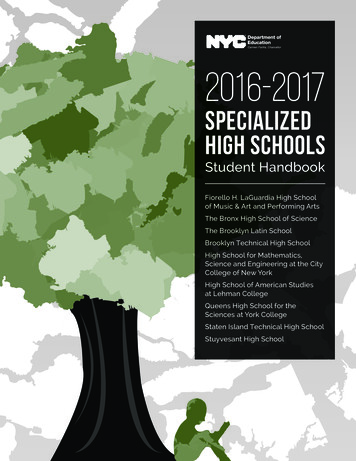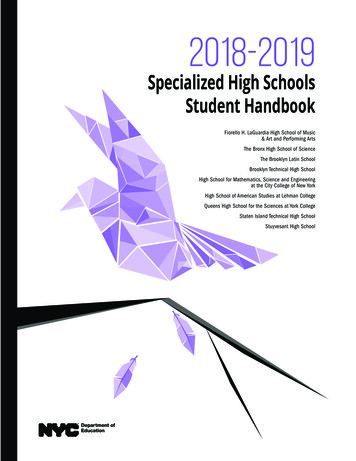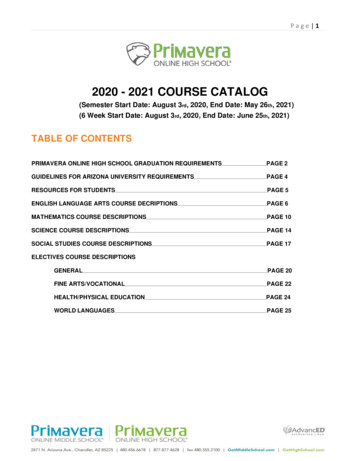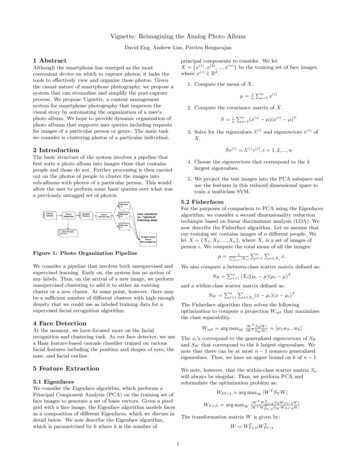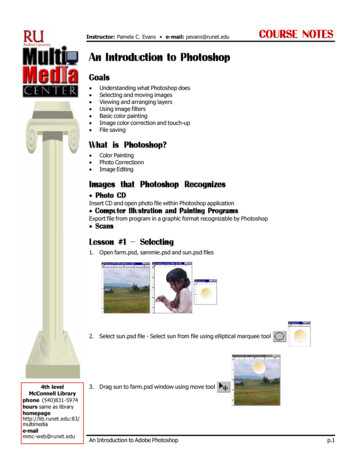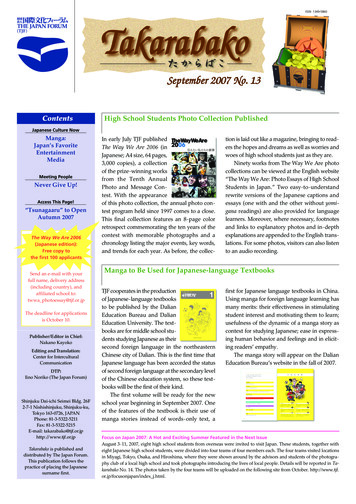
Transcription
ISSN 1349-5860ContentsHigh School Students Photo Collection PublishedJapanese Culture NowManga:Japan’s FavoriteEntertainmentMediaMeeting PeopleNever Give Up!Access This Page!“Tsunagaaru” to OpenAutumn 2007The Way We Are 2006(Japanese edition):Free copy tothe first 100 applicantsSend an e-mail with yourfull name, delivery address(including country), andaffiliated school to:twwa photoessay@tjf.or.jpThe deadline for applicationsis October 10.Publisher/Editor in Chief:Nakano KayokoEditing and Translation:Center for InterculturalCommunicationDTP:Iino Noriko (The Japan Forum)Shinjuku Dai-ichi Seimei Bldg. 26F2-7-1 Nishishinjuku, Shinjuku-ku,Tokyo 163-0726, JAPANPhone: 81-3-5322-5211Fax: 81-3-5322-5215E-mail: takarabako@tjf.or.jphttp://www.tjf.or.jpTakarabako is published anddistributed by The Japan Forum.This publication follows thepractice of placing the Japanesesurname first.In early July TJF publishedThe Way We Are 2006 (inJapanese; A4 size, 64 pages,3,000 copies), a collectionof the prize-winning worksfrom the Tenth AnnualPhoto and Message Contest. With the appearanceof this photo collection, the annual photo contest program held since 1997 comes to a close.This final collection features an 8-page colorretrospect commemorating the ten years of thecontest with memorable photographs and achronology listing the major events, key words,and trends for each year. As before, the collec-tion is laid out like a magazine, bringing to readers the hopes and dreams as well as worries andwoes of high school students just as they are.Ninety works from The Way We Are photocollections can be viewed at the English website“The Way We Are: Photo Essays of High SchoolStudents in Japan.” Two easy-to-understandrewrite versions of the Japanese captions andessays (one with and the other without yomigana readings) are also provided for languagelearners. Moreover, where necessary, footnotesand links to explanatory photos and in-depthexplanations are appended to the English translations. For some photos, visitors can also listento an audio recording.Manga to Be Used for Japanese-language TextbooksTJF cooperates in the productionof Japanese-language textbooksto be published by the DalianEducation Bureau and DalianEducation University. The textbooks are for middle school students studying Japanese as theirsecond foreign language in the northeasternChinese city of Dalian. This is the first time thatJapanese language has been accorded the statusof second foreign language at the secondary levelof the Chinese education system, so these textbooks will be the first of their kind.The first volume will be ready for the newschool year beginning in September 2007. Oneof the features of the textbook is their use ofmanga stories instead of words-only text, afirst for Japanese language textbooks in China.Using manga for foreign language learning hasmany merits: their effectiveness in stimulatingstudent interest and motivating them to learn;usefulness of the dynamic of a manga story ascontext for studying Japanese; ease in expressing human behavior and feelings and in eliciting readers’ empathy.The manga story will appear on the DalianEducation Bureau’s website in the fall of 2007.Focus on Japan 2007: A Hot and Exciting Summer Featured in the Next IssueAugust 3-11, 2007, eight high school students from overseas were invited to visit Japan. These students, together witheight Japanese high school students, were divided into four teams of four members each. The four teams visited locationsin Miyagi, Tokyo, Osaka, and Hiroshima, where they were shown around by the advisors and students of the photography club of a local high school and took photographs introducing the lives of local people. Details will be reported in Takarabako No. 14. The photos taken by the four teams will be uploaded on the following site from October. http://www.tjf.or.jp/focusonjapan/index j.html.
Japanese Culture Nowhttp://www.tjf.or.jp/takarabako/Manga:Japan’s FavoriteEntertainment MediaCharacteristics of Japanese Comics1) The mainstream is story mangaThe mainstream of manga in Japan today is “story manga” thathave clear narrative storylines and pictures dividing the pages intoframes containing dialogue, onomatopoeia “sound” effects, andother text. Reading through the frames, the reader experiences thesense of watching a movie.2) Not limited to childrenManga magazines published in Japan generally target certain ageor other groups, as in the case of boys’ or girls’ manga magazines(shonen/shojo manga zasshi), which are read mainly by elementaryand junior high school students, and “young people’s” magazines(seinen-shi) for senior high school students and older young people.3) Wide variety of themesIn the range of their themes and depth of drama, manga are as diverse as the cinema or printed fiction, everything from romance,sports, action, business, government, economy, medicine, sciencefiction, and fantasy to history, daily life, child rearing, animals, andmuch more.4) Emphasis on charactersThe popularity of a manga work depends on the main character(s).Many manga are designed to make readers reflect on a given themeby identifying with the characters.5) Publication in book form after magazine serializationA typical manga magazine consists of over 20 installments, eachbetween 10 and 20 pages in length. These stories are later published in book form. Manga stories are rarely created from the outset for publication as a book.A typical weekly boys’ manga magazine has 500 pages per issueand is sold for 250 yen. The covers and the first 10 or so pages arein color, all the rest in black and white. The photo shows three ofthe most popular weekly manga magazines.Shukan shonen jampu[Weekly Boys’ Jump]Shukan shonen magajin[Weekly Boys’ Magazine]Shukan shonen sande[Weekly Boys’ Sunday] SHUEISHA KODANSHA SHOGAKUKANJapanese pop culture, in the form of anime, manga,and computer games, has increasingly attracted attention worldwide over the last several years. Notjust a small number of enthusiasts but people ingeneral have begun to appreciate the enjoymentand sophistication of Japanese pop culture. Thisinstallment of “Japanese Culture Now” featuresmanga, Japanese comics.Chronology of PostwarJapanese Manga1940s Manga for rent at kashihon’ya (small-scale book-lending shops)win popularity Publication of Shin Takarajima [New Treasure Island] byTezuka Osamu, birth of full-fledged story manga (1947)1950s Monthly manga magazines published Inauguration of weekly manga magazines, Shukan shonen sandeand Shukan shonen magajin (1959)1960s Spread of manga reading to university students Popularity of “supo-kon manga” featuring sports (supotsu) anda never-give-up spirit (konjo)1970s All manga magazines suffer deficits due to paper shortage andsteep rise of paper costs caused by oil crisis (1973) First Comic Market held (1975)1980s “Rabu-kome” (love and comedy) manga boom Manga Nihon keizai nyumon [Introduction to Japanese Economics in Manga] a great hit and information- and study-orientedmanga draw attention (1986) Circulation of young people’s manga magazines surpasses thatof boys’ manga magazines for the first time (1989)1990s “Harmful comics” (yugai komikku, or the manga containing excessively explicit sex and violence) become controversial The weekly manga magazine, Shukan shonen jampu, achievesrecord circulation of 6.53 million copies in manga history (1995)2000s Sales of manga books surpasses that of manga magazines forthe first time (2005) Online manga distribution via the Internet and cell phonesbeginsThe “Rabu-kome” BoomUrusei YatsuraTatchi Rumiko Takahashi/SHOGAKUKAN Mitsuru Adachi/SHOGAKUKANJapanese Culture Now-1Rabu Hina Ken Akamatsu/KODANSHA
Tezuka Osamu, Founder of Story MangaTezuka Osamu laid the foundations for the modern manga genrein postwar Japan. Shin Takarajima [New Treasure Island], whichwas published in 1947 when Tezuka was still a 19-year-old medicalstudent, became a best-seller, with 400,000 copies sold. This workintroduced the cinematic techniques he adopted including multiangle shots, panning, and close-ups. Manga using such cinematiceffects came to be called story manga and story manga later becamethe most common form of comics in Japan.Tezuka’s stories were more than entertainment, giving readershigh drama revolving around characters with complex personalities.Some of his stories end in tragedy, reminding us of the transience oflife and the material world. He remained active as an artist until hisdeath in 1989 at age 61. He not only produced Tetsuwan Atomu [AstroBoy] and many other story manga series but also was a pioneer in thefield of anime. His manga have had tremendous influence on manyof the people who are now leaders in various fields, not only manga,painting and other fields of the arts, but also medicine, technology,and the sciences. He is now revered as the “god of manga.”Tetsuwan Atomu[Mighty Atom, Astro Boy]The story of a kindheartedboy robot who fights forpeace. The series startedin 1951. It was made intoJapan’s first TV animationfilm (black and white) in1963. TEZUKA PRODUCTIONS/KODANSHAHi no tori [The Phoenix]Tezuka’s life work. Hebegan this series in 1954and continued it untilhis death in 1989. Thereader witnesses thegrand drama of humankind, traveling back andforth in time betweenthe present, past, andfuture.Burakku Jakku[Black Jack]Stars the unlicensed surgicalgenius, Black Jack, depicting the preciousness andtransience of life and thesinful karma of human beings. Serialized from 1973to 1978. TEZUKA PRODUCTIONS/KODANSHA TEZUKA PRODUCTIONS/KODANSHABirth of Weekly Manga Magazines and the Supo-kon Manga EraAshita no JoKyojin no hoshiOkiku furikabutteTenisu no Oji-sama Ikki Kajiwara/Noboru Kawasaki/KODANSHA Asao Takamori/Tetsuya Chiba/KODANSHAWith the inauguration of boys’ manga magazines, Shukan shonensande and Shukan shonen magajin in 1959, manga became morepopular among children than ever. When these children becamecollege students in the latter half of the 1960s they came under astrong influence of supo-kon (the “sports and never-give-up spirit”)genre of manga, examples of which are Ashita no Jo [Tomorrow’sJoe; story of a young boxer] and Kyojin no hoshi [Star of the Giants; story of a star baseball pitcher], whose heroes trained veryhard, displayed unyielding tenacity, and defeated even the tough-Maho sensei Negi ma! Ken Akamatsu/KODANSHA Asa Higuchi/KODANSHA Takeshi Konomi/SHUEISHAest rivals. Manga were still considered a media for children in thosedays and college students who read manga became the object ofcriticism.Sports manga have continued to be popular, even today. Amongthe best-known in the 1990s were Suramu danku [Slam Dunk; featuring a basketball star] and Kyaputen Tsubasa [Captain Tsubasa; afootball/soccer hero], and more recent works include Tenisu no ojisama [The Prince of Tennis] and Okiku furikabutte [Raise the BallHigh; baseball].The late 1970s to the mid-1980s was the era of therabu-kome (love and comedy) manga. The stories areoften set in junior or senior high schools, depictingadolescent love between the main male and femalecharacters and the misunderstandings and dislocations that get in the way of their relationships. In thelove-comedy manga stories, romance is invariablyset against the backdrop of often-slapstick eventsinvolving the protagonists and other characters, andpriority is given to a balance between the elementsof serious drama and comedy. Some works of thistype were animated for television and enjoyed im-Japanese Culture Now-2mense popularity, including Urusei yatsura [NoisyPeople / Uru-planet People], Mezon Ikkoku [MaisonIkkoku], Tatchi [Touch], and Miyuki [Miyuki].Among more recent popular works are RabuHina [Love Hina], a slapstick comedy about a highschool graduate aspiring to enter the University ofTokyo who turns out to be the janitor of a girls dormitory, and Maho sensei Negi ma! [Wizard TutorNegi] about a 10-year-old boy aspiring to be an expert wizard who is assigned to teach a class of 31junior high school girls.
The World of Girls‘ MangaGirls’ manga (shojo manga) stories deal mainly with love and areusually produced by female writers and designed for a female readership. Whereas in manga for men, the stories generally proceedin linear fashion from one frame to the next, girls’ manga exhibittechniques such as no frames or drawing across frames. Other features include backgrounds covered with elaborate floral patternsand characters with big round eyes sparkling with stars.In the 1970s Hagio Moto, Takemiya Keiko, and other cartoonists expanded the scope of girls’ manga with stories based on science fiction, fantasy, and romantic love between boys. Today, girls’manga handle even more diverse themes and some works attractmany male readers, making them increasingly difficult to categorize under the “girls’ manga” genre. Among works currently drawing attention are Nana, a story of friendship and love between twogirls both named Nana, Hachimitsu to kuroba [Honey and Clover]about the youth/romantic experiences of a university art student,and Hataraki man [Working Men] about the working life as seenby a female editor. Made into animated television series or movies,they enjoy increasing popularity.NanaHataraki manHachimitsu to kuroba Moyoco Anno/KODANSHA Ai Yazawa/SHUEISHA Chica Umino/SHUEISHATrend-setting MangaChanging Manga IndustryVarious trends have been set in motion in Japan as a result ofpublication of certain manga. For instance, Nodame kantabire[Nodame Cantabile], a comedy manga set at a music college centering around a male orchestra conductor and a female pianist,created a classical music craze after it was dramatized on television and broadcast October through December 2006. It wasoriginally published in 2001 as a serial manga in Kiss, a mangamagazine targeting mainly women in their twenties and thirties.According to the Dentsu Communication Institute “White Paper onInformation Media 2003,” the value of the Japanese manga marketpeaked in 1994 at 586.4 billion yen (combined sales of books andmagazines) and has been on a decline since. With the diversificationof entertainment media brought about by the advent of cell phones,computer games, and the Internet in the 1990s, people seem to bespending less money on manga. In 2005, the sales of manga booksexceeded those of manga magazines for the first time. Digital distribution of manga via computer and cell phone has been rapidly growing in recent years, as has the copyright business for manga content.A new phenomenon in which manga stories made available firston the Internet win popularity and are then published in book formand become bestsellers is currently gaining momentum. Examplesare Kyo no Nekomura-san [Ms. Nekomura Today], the story of a catnamed Ms. Nekomura, who works as a housemaid, and Boku otariiman [I Am an Otaryman] about the daily life of a systems engineer salaryman who is an otaku (hardcore aficionado). These mangahave sold 900,000 and 300,000 copies respectively. Without goingthrough the usual process of magazine serialization first, and createdby virtually nameless authors, such works have been a great hit. Themanga world is entering a new era.Nodame kantabire was a popular manga from its first serialization, but after it was made into a TV drama, the 18-volumebook edition sold a total of 22 million copies. A CD collectionof the classic compositions that were topical in the drama sold animpressive 400,000 copies, extraordinary for a classic music CD,which is usually considered a big hit if 10,000 copies are sold.The copyright business for character goods, games, and otherproducts that use the characters appearing in the manga is increasing earnings year after year.Nodame kantabireInternet-published manga have their own websites. For Nekomura,see www.nekomura.jp and for Otariiman http://www.chukei.co.jp/blog/yoshitani/. Tomoko Ninomiya/KODANSHAKyo no Nekomura-sanBoku otariiman Yoriko Hoshi/MAGAZINE HOUSE Yoshitani/CHUKEI PUBLISHING COMPANYJapanese Culture Now-3
How to Read Japanese MangaManga magazines and books in Japan open from right to left, the opposite of Western books, andthe lines of writing are vertical. Because of these and other differences, reading Japanese manga cantake some getting used to for American and European readers. The elements that make up eachpage include pictures showing characters with background scenery, dialogue written in text balloons,and often many sound effects drawn in original lettering. Once able to quickly grasp the pictures, textin the word balloons, and sound effects, a reader can enjoy manga as if watching a movie.FramesBalloonsManga pictures are drawnin frames (koma in Japanese). Thebasic flow of reading each page is tostart from the top right frame, endingwith the bottom left frame. The skillful combination of appropriately sizedframes makes a story unfold at agood tempo and with strikingdramatic effect.Words are written in textballoons (fukidashi in Japanese). Word balloons play therole of expressing characters’feelings and describing theirsituations.12 Kurobe RenyaSound effectsThe sound of a car crash, a character’s scream, other such sounds aredescribed with various exaggerated onomatopoeia or other sound effects in manga. Thelettering of the sound-expressing words is styledto fit the situation, depending on whether a noiseis big or small, whether a vehicle is moving fastor slow, etc. The use of varied sound effectsenables the reader not only to “hear” thesounds but even to follow the fluctuations of a character’s changingemotions.3Reference: Ima sugu manga ga kakeru hon, Oyo-hen [A Practical Guide to Drawing Manga] (Bijutsu Shuppansha, 2007)Japanese Culture Now-4
Meeting PeopleAt the request of the persons featured in this issue’s“Meeting People,” the article will not be posted inPDF form on the TJF website. Thank you for yourunderstanding.Meeting People-1
http://www.tjf.or.jp/takarabako/At the request of the persons featured in this issue’s“Meeting People,” the article will not be posted inPDF form on the TJF website. Thank you for yourunderstanding.Meeting People-2
Access This Page!“Tsunagaaru” to Open Autumn 2007:A Site for Secondary Students Worldwidewww.tsunagaaru.comWhat is “Tsunagaaru”?Tsunagaaru is a communication website utilizing social networking service software. “Tsunagaaru” is a space for connecting secondary school students all over the world, no matter where theyare and what language they speak.Participantsl Community(ダミーの画像を入れる)Here is the forum where participants can propose topics anddiscuss them in depth. This is also the base for class-wide research projects.FeaturesMultidirectional Exchange, Multiple-language UseSecondary students of Japanese in other countries, Japanese students of foreign language (e.g., English, Chinese, and Korean),or students interested in international understanding.What Tsunagaaru Will AchieveMutual Understanding among Junior and Senior High SchoolStudents around the WorldThrough exchange via the website and in direct exchange programs, Tsunagaaru will seek to transcend national boundaries and language barriers to promote mutual person-to-personunderstanding among junior and senior high school studentsaround the world. It will make possible exchange among multiple countries and languages, and in multiple directions.Transmission of Culture via IndividualsTsunagaaru will transmit information about language, culture, andsociety from the viewpoint of individuals. This will provide opportunities for understanding of diverse cultures and social conditions through the experience of contemporaneous individuals.Foreign Language StudyTsunagaaru will make it possible for students to use the languageskills they are learning in actual communication experiences, andwe hope thereby to heighten their incentive to pursue foreignlanguage study.As a common forum where junior and senior high school studentsof multiple countries and regions can engage in multi-directionalexchange of ideas and information, Tsunagaaru goes beyond thekind of two-way exchange previously common between, for example, Japanese and American high school students or betweenJapanese and Australian junior high school students. To facilitatethis exchange, the site enables viewers to freely view and post comments in Chinese, English, Japanese, and Korean. TJF will introduceInternet machine translation sites that might be of some help.Exchange in a Safe EnvironmentIn order to protect the privacy of members and secure the social networking environment, TJF will check the student statusof those who register for the site and obtain the assent of theirparents or guardians. Texts posted for the site will be checked toassure the content does not contain personal information or inappropriate expressions.Enhancing Face-to-face Exchange OpportunitiesTJF will conduct programs that organically tie together exchangevia the website with actual face-to-face exchange programs.How to ParticipateStudent RegistrationPlease register from the Tsunagaaru site.Note to TeachersMain ContentA Registered Members-only Social Networking Sitel My PageHere each participant will have a personal page to post a profile, essays (diary-like messages), etc. This page gives each member the opportunity to give expression to his or her personalthoughts or discoveries in the form of text and photographs.Other members can post comments to these pages, promotingexchange of ideas and views about the content posted on thesepersonal pages.Tsunagaaru is, in principle, a site open only to secondary schoolstudents, but TJF will provide open access for one week to teachers who contact us desiring to introduce it to their students.Teachers who want to create a class-wide community on Tsunagaaru should contact us for details on how to proceed.For examination access for teachers and other queries, pleasecontact us at:tsunagaaru@tjf.or.jpAccess This Page!
manga draw attention (1986) Circulation of young people's manga magazines surpasses that of boys' manga magazines for the first time (1989) 1990s "Harmful comics" (yugai komikku, or the manga containing ex-cessively explicit sex and violence) become controversial The weekly manga magazine, Shukan shonen jampu, achieves

